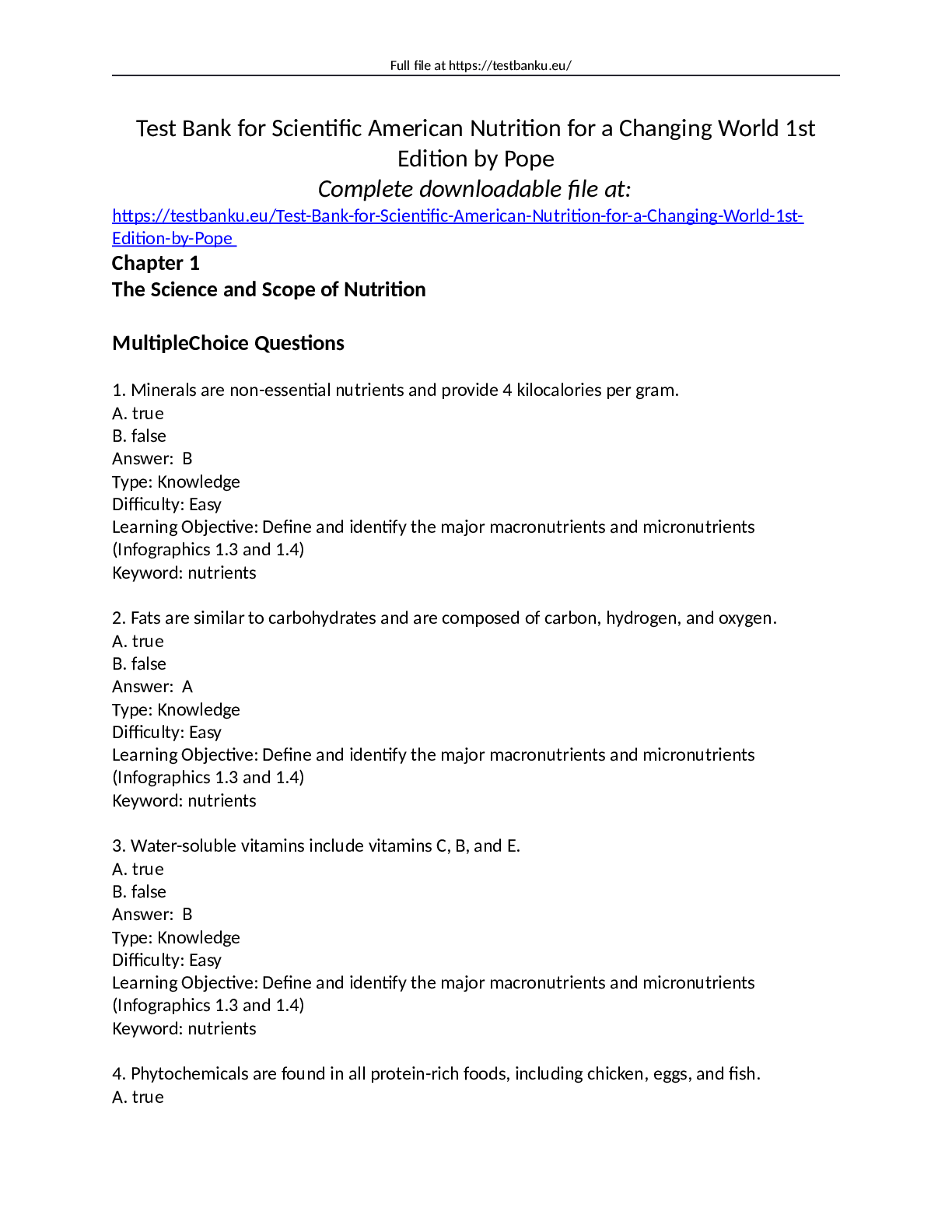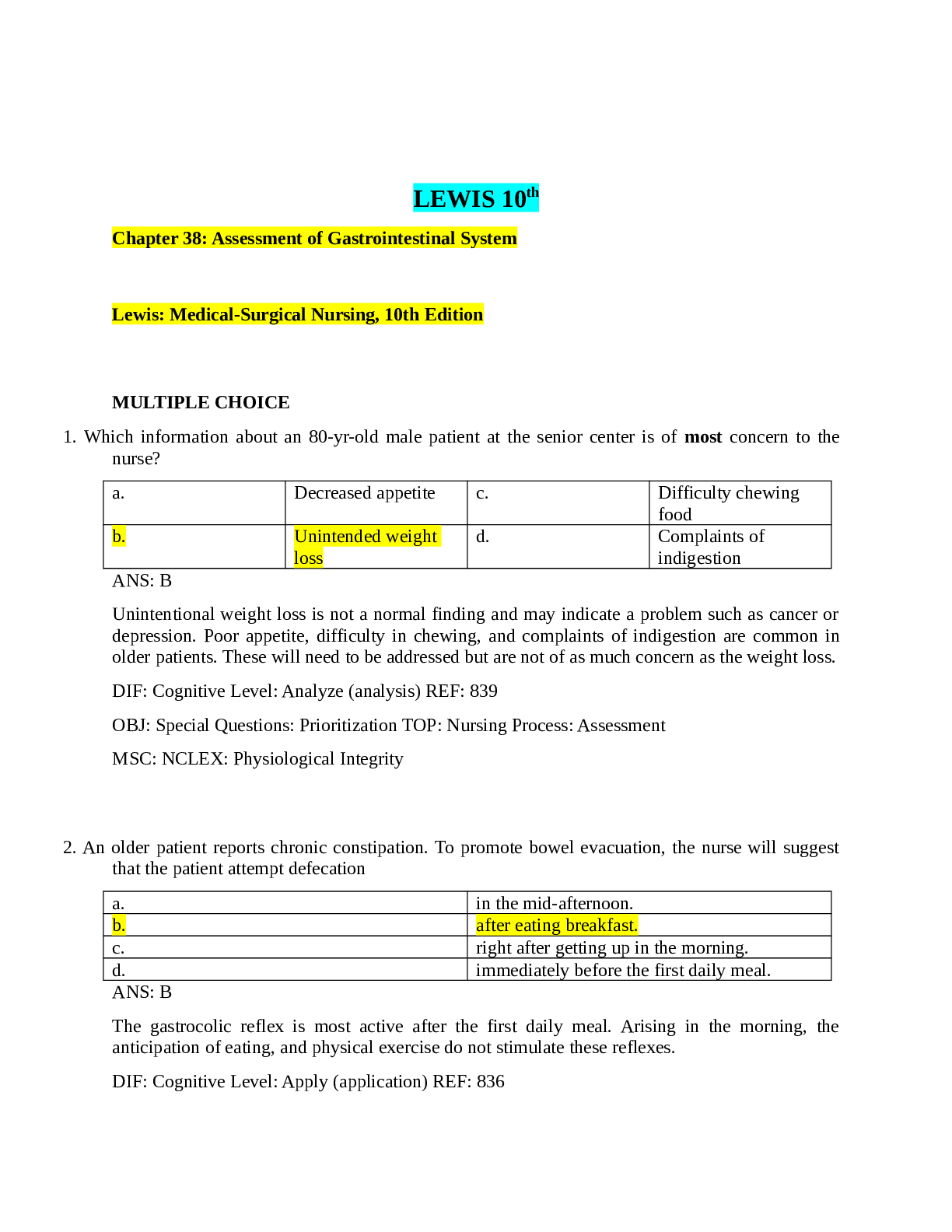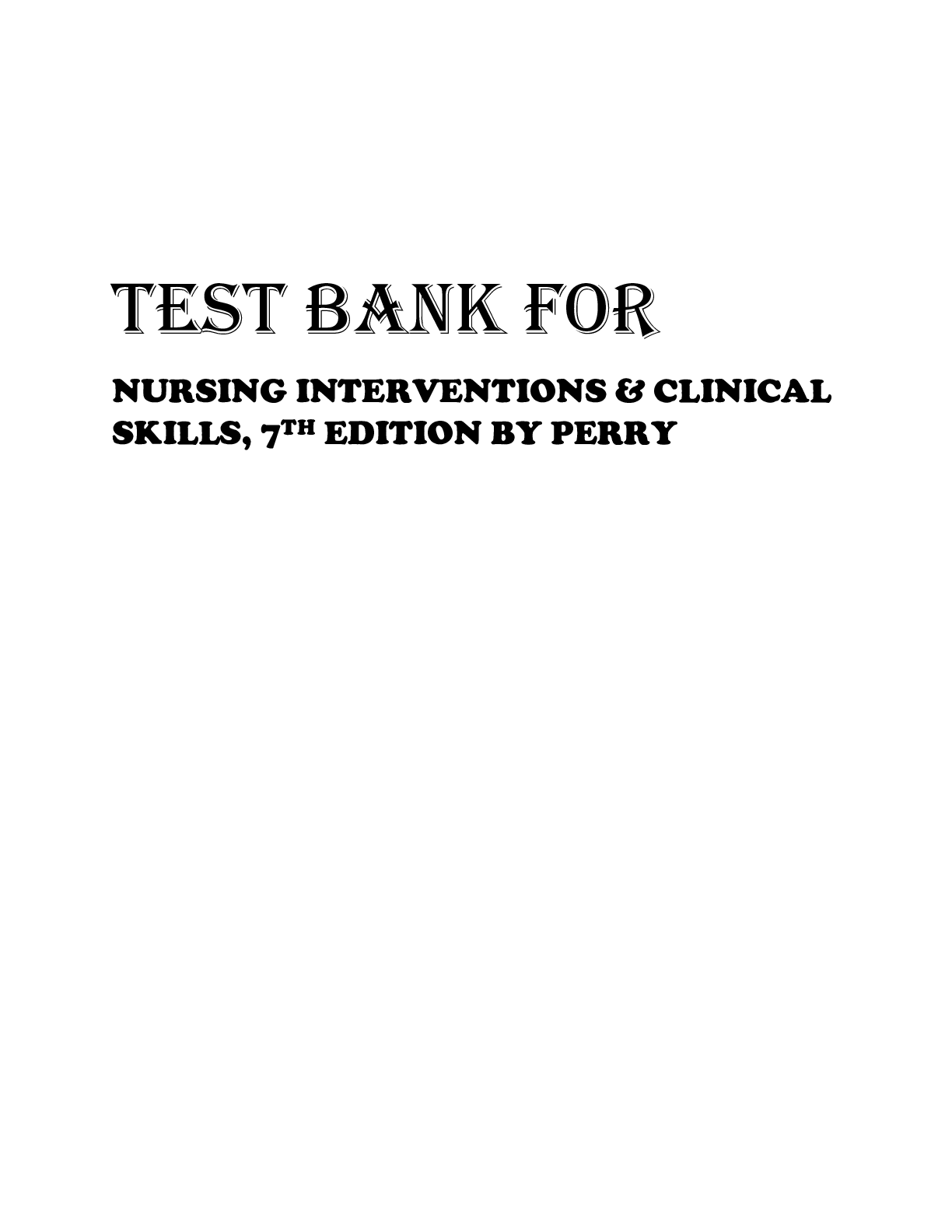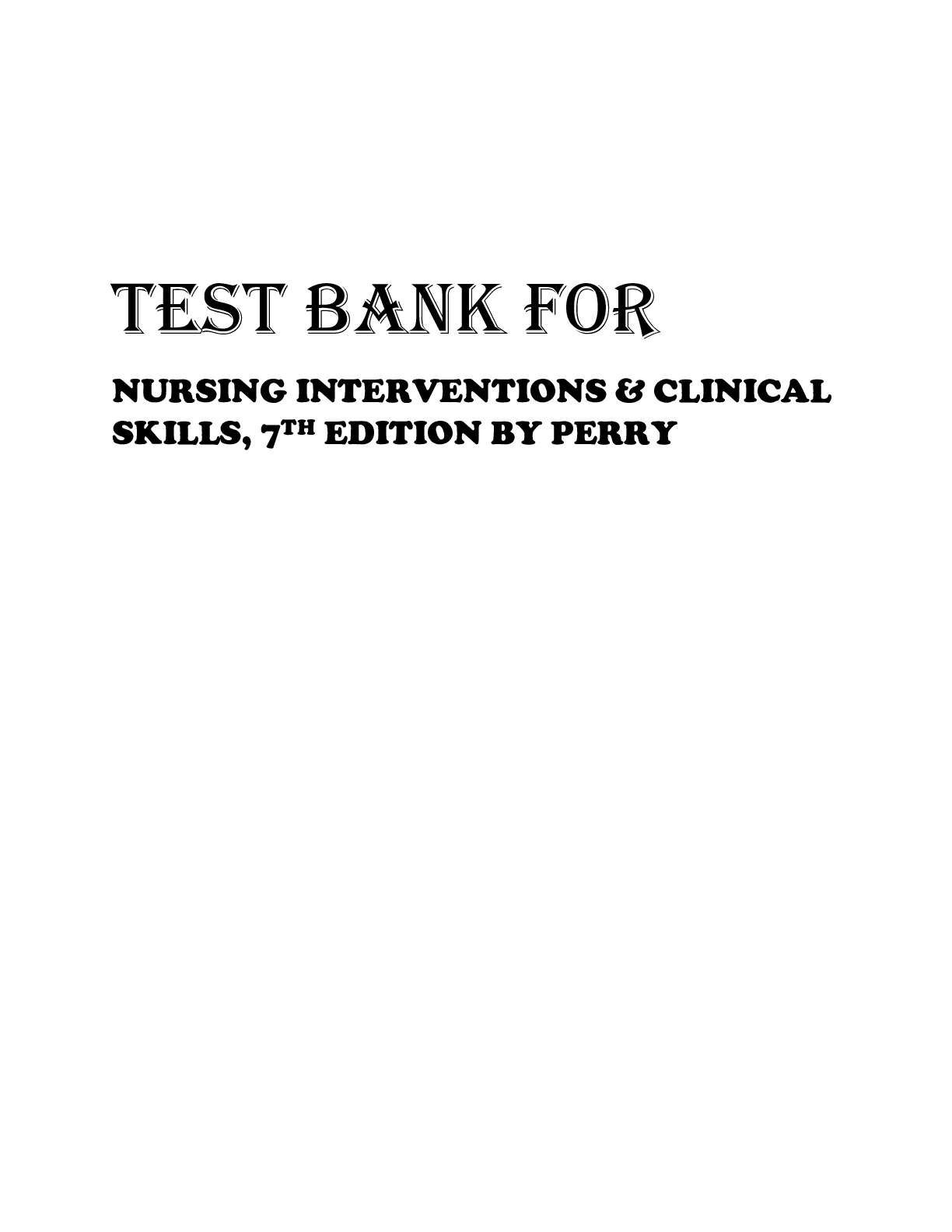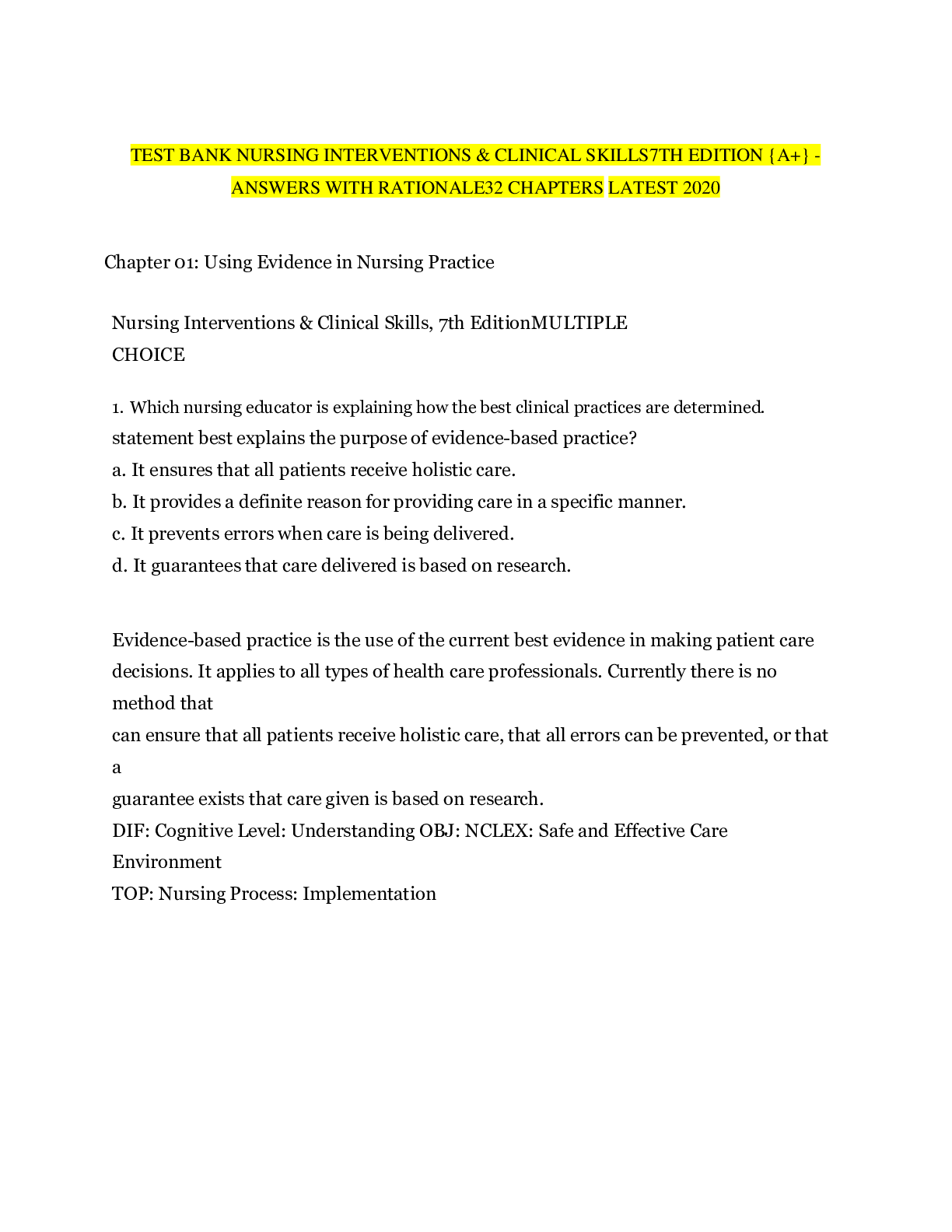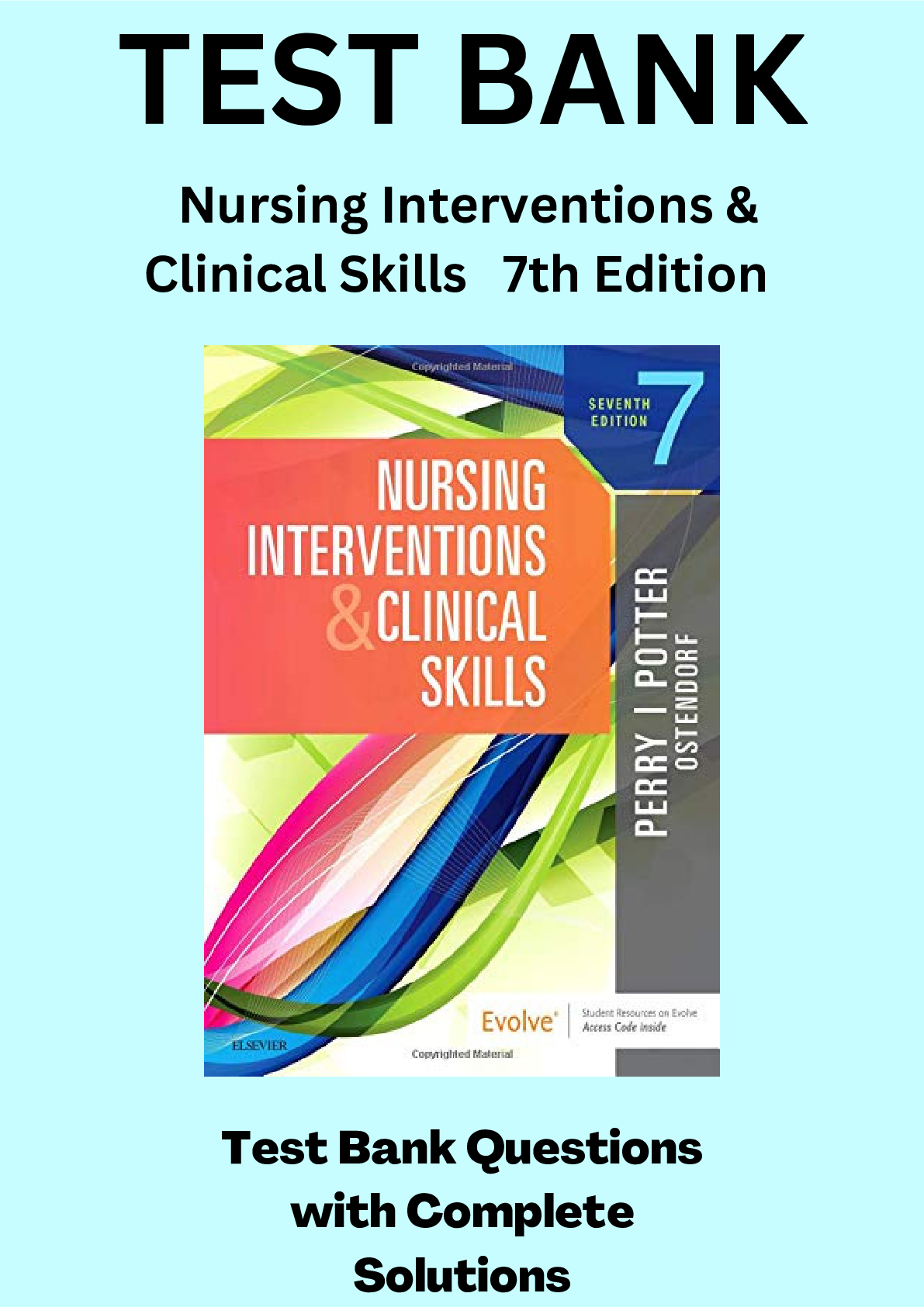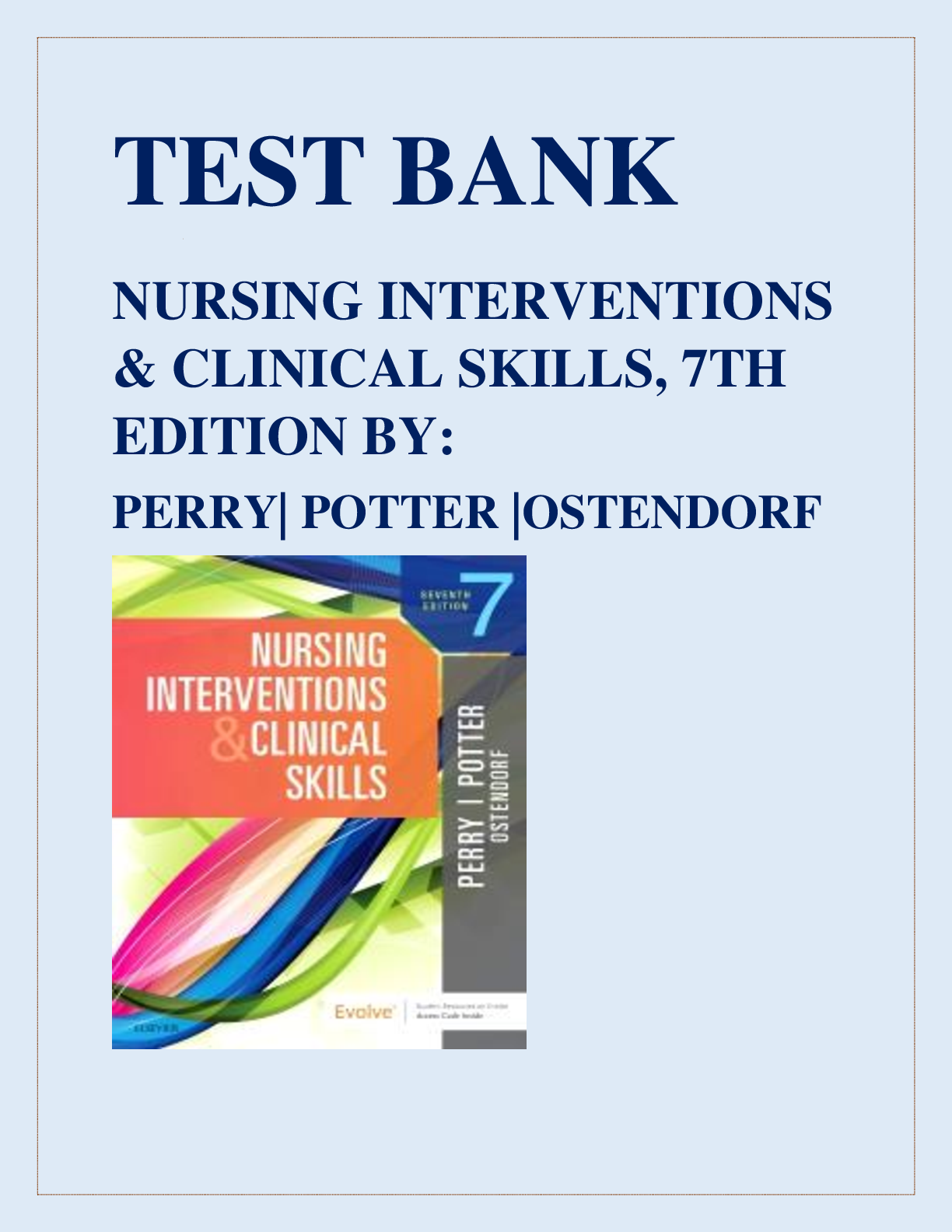Nursing Interventions & Clinical Skills Test Bank 100% Latest Update
Document Content and Description Below
MULTIPLE CHOICE 1. A nursing educator is explaining how the best clinical practices are determined. Which statement best explains the purpose of evidence-based practice? a. It ensures that all pati... ents receive holistic care. b. It provides a definite reason for providing care in a specific manner. c. It prevents errors when care is being delivered. d. It guarantees that care delivered is based on research. ANS: B Evidence-based practice is the use of the current best evidence in making patient care decisions. It applies to all types of health care professionals. Currently there is no method that can ensure that all patients receive holistic care, that all errors can be prevented, or that a guarantee exists that care given is based on research. DIF: Cognitive Level: Understanding OBJ: NCLEX: Safe and Effective Care Environment TOP: Nursing Process: Implementation 2. Which question is a problem-focused trigger for initiating the evidence-based practice method in nursing care? a. What is known about reduction of urinary tract infections in the older adult with diabetes? b. How can chronic pain best be described when the patient is nonverbal? c. How long can an IV catheter remain in place in a patient with obesity? d. What measures can the nurse take to reduce the rising incidence of urinary tract infections on the older adult care unit? ANS: D Evidence-based practice (EBP) questions tend to arise from two sources: recurrent problems or new knowledge. In the correct option, the increase in urinary tract infections indicates a trend or recurring problem in a specific group of patients. The other questions are general information questions, not based on what is happening in a specific area or to a group of specific patients in an area or relating to an observed trend. DIF: Cognitive Level: Applying OBJ: NCLEX: Safe and Effective Care Environment TOP: Nursing Process: Implementation 3. What does the “I” indicate in a “PICO” question? a. Intervention of interest b. Incorporation of concepts c. Implementation by nursing d. Interest of personnel ANS: A The “I” stands for intervention of interest, meaning what the nurse hopes to use in practice and believes is worthwhile or valuable. This could be a treatment for a specific type of wound or an approach on how to teach food preparation for a patient with impaired sight. TEST BANK FOR NURSING INTERVENTIONS AND CLINICAL SKILLS 7TH EDITION BY POTTER TESTBANKWORLD.ORG N DIF: Cognitive Level: Remembering OBJ: NCLEX: Safe and Effective Care Environment TOP: Nursing Process: Implementation 4. Who will the clinical research nurse contact to search relevant databases in preparation for an upcoming study? a. The physician whose patients may be involved in the study b. The medical librarian c. The nurse manager of the unit where the study will be conducted d. The director of nursing of the facility ANS: B The medical librarian is most knowledgeable regarding databases relevant to a study. The other individuals do not have the knowledge regarding relevant databases. DIF: Cognitive Level: Understanding OBJ: NCLEX: Safe and Effective Care Environment TOP: Nursing Process: Implementation 5. Which database contains summaries of clinical guidelines and their development? a. MEDLINE b. CINAHL c. Cochrane Database of Systematic Reviews d. The National Guideline Clearinghouse ANS: D The National Guideline Clearinghouse is a database supported by the Agency for Healthcare Research and Quality. It contains summaries of clinical guidelines for practice. MEDLINE is a database for studies in medicine, nursing, dentistry, psychiatry, veterinary medicine, and allied health. CINAHL (Cumulative Index of Nursing and Allied Health Literature) includes studies in nursing, allied health, and biomedicine. The Cochrane Database Full text of regularly updated systematic reviews prepared by the Cochrane Collaboration includes completed reviews and protocols. DIF: Cognitive Level: Remembering OBJ: NCLEX: Safe and Effective Care Environment TOP: Nursing Process: Implementation 6. Which does the nurse researcher identify as the strongest type of research? a. Randomized controlled trials b. A qualitative study c. A descriptive study d. A case controlled study ANS: A Individual randomized controlled trials are close to the top of the research pyramid. Only systematic reviews and meta-analyses are higher. This type of study tests an intervention against the usual standard of care. The other types of studies are useful but do not give the same type of information as a randomized controlled trial provides. DIF: Cognitive Level: Remembering OBJ: NCLEX: Safe and Effective Care Environment TOP: Nursing Process: Assessment TEST BANK FOR NURSING INTERVENTIONS AND CLINICAL SKILLS 7TH EDITION BY POTTER TESTBANKWORLD.ORG N 7. What is the nurse attempting to determine when critiquing the evidence related to a PICOT question? a. The ethical conduct of the research the nurse read b. The strength of the evidence found in the literature c. If there are any experts in the clinical question needing to be researched d. If the study demonstrates cost-effectiveness if a change in practice occurs ANS: B Once a literature search is complete and data are gathered about the question, it is time to critique the evidence. Critiquing the evidence involves a systematic approach to looking at the strength of the work reviewed and its relevance. The other questions are not applicable to critiquing the evidence. DIF: Cognitive Level: Understanding OBJ: NCLEX: Safe and Effective Care Environment TOP: Nursing Process: Implementation 8. A nurse finds a cohort study comparing one group taking hormone treatment with another group not taking hormone treatment to determine the incidence of changes in bone density of the lower spine. What can the nurse imply from this study? a. Low level of strength makes the study limited in value. b. Moderate level of strength makes the study probably useful. c. Opinions of the individuals in the cohort are not research. d. This could be the basis for a Quality Improvement project. ANS: B A cohort study is Level 4 evidence as it is a single, non-experimental study. This moderate level of evidence makes the study probably useful but the nurse should strive to find stronger evidence. DIF: Cognitive Level: Applying OBJ: NCLEX: Safe and Effective Care Environment TOP: Nursing Process: Evaluation 9. Which question would be the best example of a knowledge-focused trigger for conducting an evidence-based practice project? a. What is the best method for treatment of leg swelling when a patient is taking gabapentin (Neurontin)? b. How can we decrease the incidence of skin cancer in adults over the age of 65? c. What is the current evidence for improving oral intake for cancer patients with stomatitis? d. What is the maximal length of time our hospital allows irrigation kits to be used? ANS: C Evidence-based practice (EBP) questions tend to arise from two sources: recurrent problems or new knowledge. In this example, the new knowledge that drives the question is the one looking at current evidence. The other questions do not look at the newest knowledge to form a question to research. DIF: Cognitive Level: Analyzing OBJ: NCLEX: Safe and Effective Care Environment TOP: Nursing Process: Implementation MULTIPLE RESPONSE TEST BANK FOR NURSING INTERVENTIONS AND CLINICAL SKILLS 7TH EDITION BY POTTER TESTBANKWORLD.ORG N 1. When planning to implement an evidence-based practice strategy, what factors are most important for the nurse to consider and include? (Select all that apply.) a. Time required to perform the strategy b. Patient preferences and values c. Clinical expertise d. Scientific knowledge e. Historical practices ANS: B, C, D When implementing evidence-based practice, the nurse considers and includes clinical expertise and patient preferences and values in addition to the scientific knowledge. Time required to perform the new strategy and customary practices are not vital to this approach. In fact, EBP seeks to ensure practices are based on evidence and not just historical practice. DIF: Cognitive Level: Remembering OBJ: NCLEX: Safe and Effective Care Environment TOP: Nursing Process: Implementation 2. A new nurse wants to ensure practice is based on the best knowledge available. What actions are best for this nurse to be involved in evidence-based practice? (Select all that apply.) a. Design and conduct a study based on interest. b. Join the hospital’s policy review committee. c. Remain vigilant for recurring problems. d. Maintain a spirit of inquiry. e. Read current literature appropriate to practice area. ANS: B, C, D, E This novice nurse would best maintain an evidence-based nursing practice by joining policy review committees, watching for and taking note of recurring problems in the practice area, maintaining a spirit of inquiry, and staying current in the literature. The nurse would not need to design and conduct a study. DIF: Cognitive Level: Applying OBJ: NCLEX: Safe and Effective Care Environment TOP: Nursing Process: Implementation 3. When explaining the value of evidence-based practice, what benefits does the nurse include? (Select all that apply.) a. Improves quality of care. b. Improves patient outcomes. c. Improves stakeholder satisfaction. d. Incorporates near real-time data in practice. e. Helps nurses remain current in practice. ANS: A, B, D, E There are five ways that EBP adds value to the health care system: helps clinicians remain current on standardized, evidence-based protocols; uses near real-time scientific data to make care decisions; improves transparency, accountability, and value (e.g. safe care); improves quality of care; and improves outcomes. One would hope all stakeholders would be more satisfied with this method of determining care but that is not one of the specific benefits. DIF: Cognitive Level: Remembering OBJ: NCLEX: Safe and Effective Care Environment TOP: Nursing Process: Implementation TEST BANK FOR NURSING INTERVENTIONS AND CLINICAL SKILLS 7TH EDITION BY POTTER TESTBANKWORLD.ORG N Chapter 02: Communication and Collaboration Perry et al.: Nursing Interventions & Clinical Skills, 7th Edition MULTIPLE CHOICE 1. The nurse interviews a patient during admission. Which observation by the nurse identifies consistency between the patient’s verbal and nonverbal communication? a. Asserts she is eager to answer questions while reading a magazine. b. States that he wants information while frequently changing the subject. c. Asks the nurse to explain a surgical procedure while she listens intently. d. Explains that he is relaxed while continuously shifting in his chair. ANS: C The patient demonstrates congruency, or consistency, between her verbal statement asking for an explanation and her nonverbal cue of listening intently. The verbal and nonverbal messages match; each indicates that the nurse’s response is important to her. If she is eager to answer questions, the patient should focus on the nurse’s questions or note taking; reading a magazine is a distraction and indicates a lack of interest. Changing the subject may indicate discomfort or reluctance to address the issue. Continually shifting position may be an indication of anxiety. DIF: Cognitive Level: Applying OBJ: NCLEX: Safe and Effective Care Environment TOP: Nursing Process: Assessment 2. The nurse is interviewing a newly admitted patient. Which statement by the nurse is most likely to result in effective patient communication? a. “I’m not sure why you’re here. Can you explain it to me?” b. “Tell me about things and people that are important to you.” c. “Tell me more about your pain. Where does it start?” d. “If you think it’s important, I’ll try to notify the provider.” ANS: C The nurse communicates effectively by using focused questions. This encourages the patient to give more information about the specific topic of concern. The remaining options are ineffective communication techniques because each potentially impairs the exchange of information between the nurse and the patient regarding care needs. The patient may be unwilling to express concerns openly after the nurse expresses lack of understanding and empathy. The patient will also likely lose confidence in the nurse if the nurse expresses confusion about suitability of the patient’s presence. By asking what is important to the patient, the nurse loses focus of the objective of the communication and is likely to confuse the patient. DIF: Cognitive Level: Applying OBJ: NCLEX: Safe and Effective Care Environment TOP: Integrated Process: Communication and Documentation 3. After receiving a diagnosis of a fatal disease, the patient expresses sadness and states “I don’t know what to do next”. Which action by the nurse best facilitates communication at this time? a. Sit quietly with the patient and observe nonverbal communication. b. Reassure the patient that his family will take care of him. c. Refer the patient to a church for spiritual counseling. TEST BANK FOR NURSING INTERVENTIONS AND CLINICAL SKILLS 7TH EDITION BY POTTER TESTBANKWORLD.ORG N d. Tell the patient that hospice care is available immediately. ANS: A Because of the grim diagnosis, the patient expresses confusion and lacks a clear direction. The patient is not able to process information at this time and is overwhelmed. Sitting quietly with the patient shows acceptance, empathy, and allows the nurse to observe nonverbal communication. The patient can benefit from a calming atmosphere and time to process the new information. Assuring the patient of family involvement requires consultation with the family first. Spiritual counseling may not be indicated for this patient if the patient does not wish to participate. Discussing hospice at this early stage is premature; the patient needs time to process the news and gather information but is not able to do so right now. [Show More]
Last updated: 1 year ago
Preview 1 out of 318 pages
Instant download

Buy this document to get the full access instantly
Instant Download Access after purchase
Add to cartInstant download
Reviews( 0 )
Document information
Connected school, study & course
About the document
Uploaded On
Aug 26, 2021
Number of pages
318
Written in
Additional information
This document has been written for:
Uploaded
Aug 26, 2021
Downloads
0
Views
93

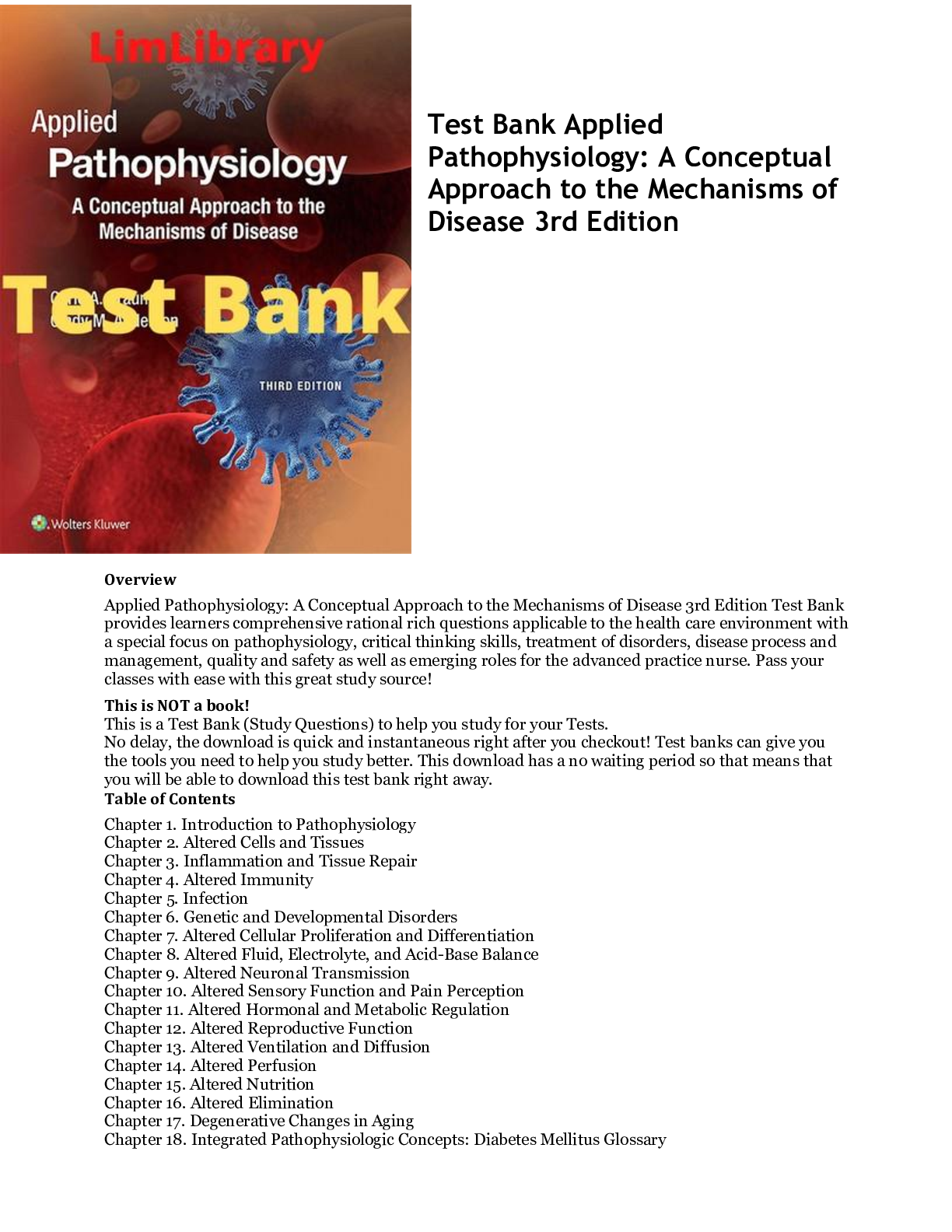

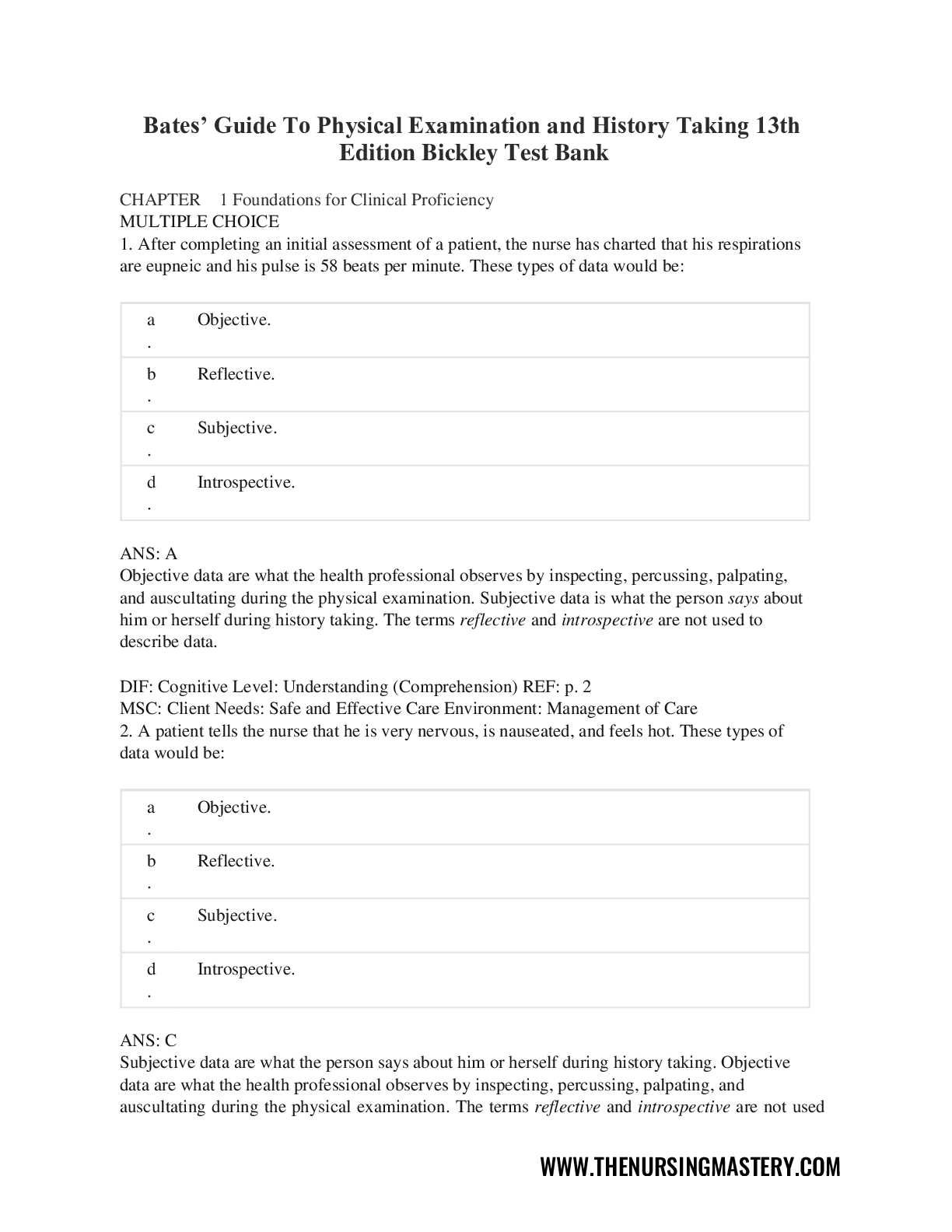
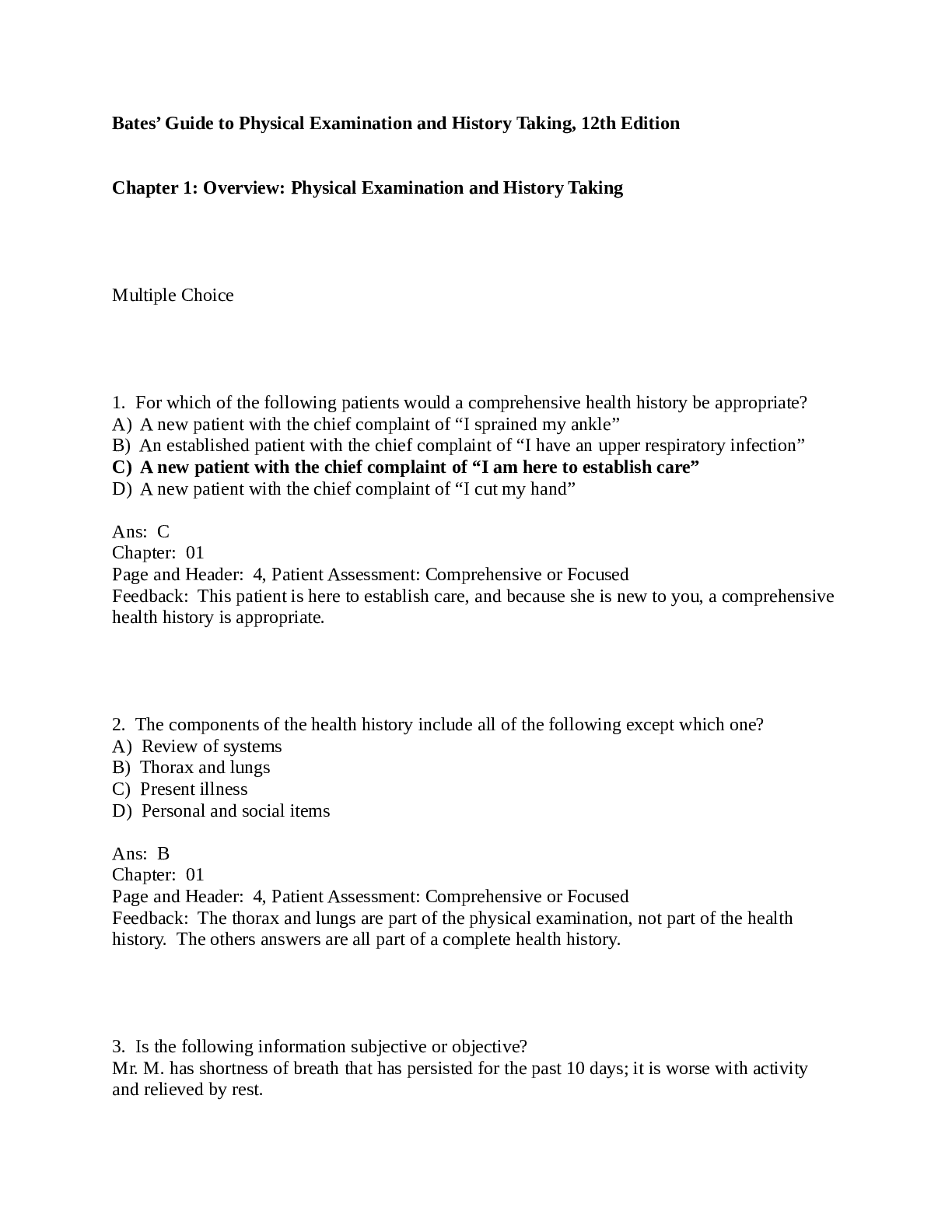
.png)
.png)
.png)

